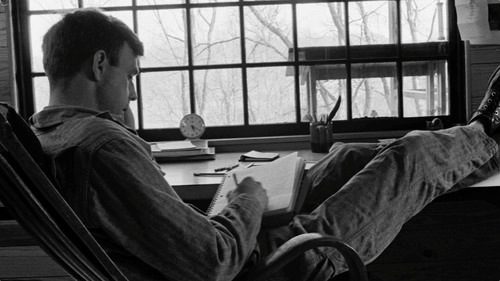
Wendell Berry, at his writing desk (Photo courtesy www.theseerfilm.com)
Gang, Julie and I recently got to see The Seer, a new documentary about Wendell Berry by Austin-based filmmaker Laura Dunn and her husband Jef Sewell. It is an astonishing work. We sort of know Laura and Jef, and I’ve known for a while that she’s been working on this Berry doc. Berry is her favorite writer, and she is passionate about family farms and agrarianism. I had seen Laura’s earlier film The Unforeseen, which played at Sundance, and knew what she was capable of. I’ve been eagerly awaiting The Seer, which Laura and Jef have been working on for seven years (they have six kids, by the way).
It does not disappoint. The texture of the film is rich, the tone poetic. In fact, it feels less like a documentary than a visual poem. Dunn and Sewell do in film what Wendell Berry does with poetry. I can’t wait to watch it again, and am thrilled to think of how The Seer will be received around the country. The film is in part a portrait of Berry, but more an exploration of his prophetic vision of America and its land. If Terrence Malick had made a documentary about Wendell Berry, it would look and feel a lot like this one. In fact, Malick is a friend of the directors, and an executive producer (with Robert Redford) of The Seer, but the work is all the young couple’s. I bring Malick’s name into it to give you a sense of the high aesthetic level at which Dunn and Sewell are working in this film. It’s simply a gorgeous, gorgeous movie.
Here’s a recent story from Modern Farmer about the movie. Excerpts:
The film, “The Seer: A Portrait of Wendell Berry,” directed by Laura Dunn and Jef Sewell (also the producer) and executive produced by Robert Redford and Terrence Malick, is as much a love letter to family farmers and the rural country, where Berry has deep family roots, as it is a straight-ahead portrait of the author.
Dunn, 40, felt a documentary about Berry needed to be more than a traditional head-on interview, interspersed with B roll. Early on, she was inspired by Berry’s 40-pane window for a way to present her subject. Like the painter Chuck Close’s portraits, which are made up of small abstract units that together create a subject’s likeness, Dunn focused her camera on the landscape, people, and past to give us a deeper understanding of Berry’s life and works—so it’s not so much about Berry himself, but instead, what he sees around him.
The film is shot “across four seasons in the farming cycle … [and] blends observational scenes of farming life, interviews with farmers and community members with evocative, carefully framed shots of the surrounding landscape, according to the film’s website. In an unusual move for a documentary about a living person, the camera is never turned directly on its subject.
“It was clear to me through my conversations with Wendell—and reading his texts about computers, screens, and media—that this is a person who is very skeptical of screens, and as a filmmaker that’s a challenge,” says Dunn. “If you want to draw a portrait of someone, what you’re trying to do is capture in some small way some reflection of the essence of that person. With Wendell, it occurred to me early on that this couldn’t be a biopic. That wouldn’t capture the complexity of him in my mind.”
Found out that Laura and Jef just launched a Kickstarter campaign to pay for final post-production costs before the film launches at South by Southwest this month. If you love Wendell Berry and what he stands for, please considering donating. Trust me, you won’t regret it. The whole thing was filmed in Henry County, Kentucky, in its fields and woods, and among its farm families. Tanya Berry appears on screen, as does her and Wendell’s daughter, Mary. I don’t want to diminish the considerable aesthetic achievement of The Seer, but for Berry admirers, this movie is one for the heart, a portrait of an artist by artists, and a tribute to an American visionary by a couple half his age whom he taught to see straight and true.
Even if you don’t plan to donate, go to the Kickstarter page to hear a short excerpt of one of Laura’s interviews with Wendell Berry, in which he talks about the age of divorce and dandelions.
[image]https://www.theamericanconservative.com/wp-content/uploads/2016/03/SeerPanoramicStills_0012_Layer-22.jpg[/image]
Tanya Berry (Photo courtesy www.theseerfilm.com)